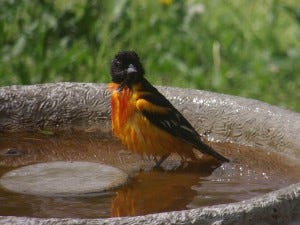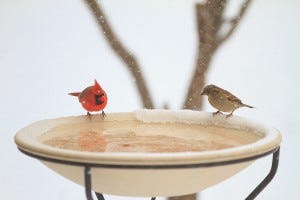Just like us, our wild bird friends need water for survival. Whether our backyard visitors are cleaning their plumage or just washing down their food; water is the best way to attract birds and complement a birdscaped backyard. One of the easiest ways to bring a water source to your yard is to add a bird waterer.
How to Place Bird Waterers
Bird waterers look a lot like bird feeders – the only difference is that you fill them with water instead of seed. They work wonderfully when placed near a seed-filled feeder, but you should take a few precautions when placing one in your yard.
- ABOVE A FEEDER – When most birds use a bird feeder, they pluck a seed from the feeder, crack it open, let the hull drop and eat the seed heart. If you place a waterer near a feeder, make sure the tray of the waterer is higher than the seed feeder. Otherwise, the water will become cluttered with seed hulls in a very short time.
- OUT OF THE SUN – Keep a bird waterer out of the direct sunlight. Too much sun can cause an algae bloom inside and even promote bacteria growth.
- WHERE YOU CAN REACH IT – Once your bird waterer gets noticed, you’re going to find it can get drained quickly by the thirsty birds in your neighborhood! That means you’ll want to place the waterer where it’s easy to remove for refilling and cleaning.
Of course, Perky-Pet® offers a top-filling bird waterer that you don’t need to take down to refill it. Just hold your hose over it and fill it up! - NEAR COVER, BUT NOT TOO CLOSE – As with bird feeders, you should place your bird waterer in an area that’s generally open, but within 10-20 feet from cover. When surprised, birds prefer to quickly zip to the safety of a tree or shrub. That puts more leaves and branches between a bird and a potential predator.
Other Water Sources
Of course your birds may be finding water elsewhere on your property, and you should also consider these when you’re trying to make a safe environment for them.

- BIRD BATHS – It’s safe to say that wild birds would have a hard time cleaning the dust and debris out of their feathers with just a waterer. So consider adding a bird bath. Place the bath in the shade wherever possible but also be conscious of shrubs that could house potential predators. Bird baths should be between 1 and 3 inches deeps and with sloped sides. Also, the bird baths made with heavy plastic are best since concrete bird baths can crack in freezing weather.
- RAIN BARRELS – Open rain barrels can pose a drowning hazard to birds and other wildlife. To protect them, simply place a tree branch about the height of the barrel inside it. The branch will give birds and other creatures a ladder to escape if they fall while getting a drink.
- EAVESTROUGHS – While you generally don’t want to have standing water inside your eavestroughs, you should know that birds can drink from them. We wouldn’t advise you to let water linger in an eavestrough – such an environment can be a breeding ground for mosquitoes!
- POOLS – Your backyard pool may attract thirsty birds and other critters. In general, this isn’t a good match for your birds. Since a pool is so deep, it’s difficult for a waterlogged bird to escape. Your best bet is to not make a pool appealing to birds by keeping it covered whenever possible.
- PUDDLES – While you may see that puddle in your driveway as a nuisance, the birds love it despite the dangers it can pose to them. The problem comes from puddles near roadways, which can be an unintended collection point for chemicals used in automobiles. You don’t want your backyard birds ingesting oil, antifreeze, gasoline and wiper fluid! To help your birds, try filling in those roadside puddles, but consider leaving those that aren’t so exposed to such pollutants.
- PONDS – If you have a man-made or natural pond on your property, then you’re probably supporting dozens of birds! Ponds that have easy to navigate shorelines with gentle slopes are best for backyard birds. That gives them plenty of opportunities to bathe and drink. Adding an aerator or fountain will also help it from going stagnant.
Cold Weather Water Sources for Birds
 As you install a water feature in your yard, remember that your birds will need water during cold weather too. A frozen bird bath or an iced-over pond won’t help them. Sure, birds can and do eat snow, but doing so actually saps their energy because they have to melt it with their body heat.
As you install a water feature in your yard, remember that your birds will need water during cold weather too. A frozen bird bath or an iced-over pond won’t help them. Sure, birds can and do eat snow, but doing so actually saps their energy because they have to melt it with their body heat.
You can help them avoid that unnecessary energy expenditure by thawing frozen water sources. Try installing heaters in bird baths and ponds. A waterer is even easier! Simply bring it in at night and let it unthaw inside the house.
Helping Birds
Whatever you decide to do to provide water for your backyard birds, they’ll appreciate it. Just make sure that your new backyard water source stays clean. You also want to monitor it during temperature extremes – during hot weather it can disappear fast and in cold weather your birds’ water source can freeze.
Happy bird watering!








